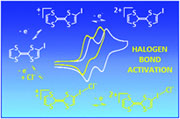Publication
798
Phys. Chem. Chem. Phys., 18 (23),15867-15873, 2016
DOI:10.1039/C6CP02219G
|
|
|
|
|
|
 |
Electrochemical activation of a tetrathiafulvalene halogen bond donor in solution |
|
|
|
Raquel Oliveira, Sihem Groni, Claire Fave, Mathieu Branca, François Mavré, Dominique Lorcy, Marc Fourmigué, and Bernd Schöllhorn
Laboratoire d'Electrochimie Moléculaire, UMR CNRS 7591, Université Paris Diderot, Sorbonne Paris Cité, Bâtiment La-voisier, 15 rue Jean-Antoine de Baïf, 75205 Paris Cedex 13, France
Institut des Sciences Chimiques de Rennes, Université Rennes 1, CNRS UMR 6226 Campus de Beaulieu, 35042 Rennes, France
The halogen bond donor properties of iodo-tetrathiafulvalene (I-TTF) can be electrochemically switched and controlled via reversible oxidation in the solution phase. Interestingly the activation of only one single halogen bond yielded already a strong and selective interaction, quantified by cyclic voltammetry. The standard potentials of the redox couples I-TTF0/1+ and I-TTF1+/2+ were observed to shift upon the addition of halides. These anions selectively stabilize the cationic I-TTF species through halogen bonding in polar liquid electrolytes. The thermodynamic affinity constants for chloride and bromide binding to the oxidized species have been determined. Competition in halide binding between I-TTF1+ and other halogen bond donors allowed for comparing the relative donor strength of the respective electrophilic species. Furthermore it has been shown that halogen bonding can prevail over hydrogen bonding in the investigated system. |

